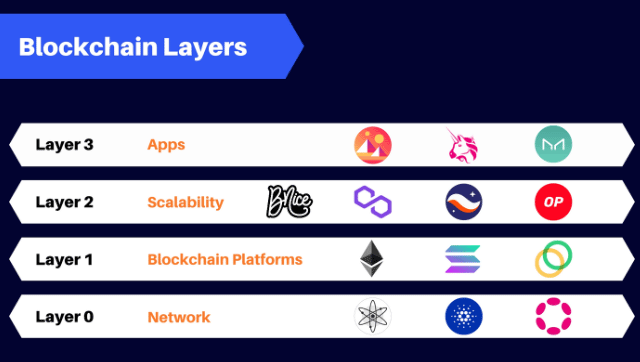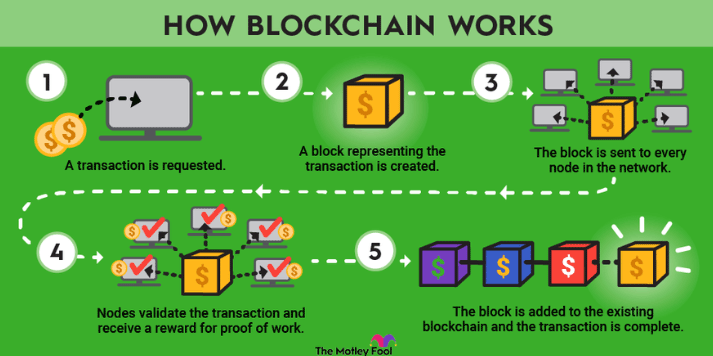|
This notebook is maintained by a network of computers, and once information is written, it cannot be changed. This makes blockchain incredibly trustworthy for things like transferring money, tracking ownership, or even verifying identities.
Layers of Blockchain
The foundational layer (Layer 0) that enables blockchains to exist. It includes the infrastructure, protocols, and networks that allow different blockchains to communicate and interact. Think of it as the internet for blockchains. Examples include Polkadot and Cosmos, which allow multiple blockchains to work together seamlessly.
Now, let’s talk about Layer 1 and Layer 2. These terms refer to different levels of blockchain infrastructure. Layer 1 is the base layer, the main blockchain itself. Examples of Layer 1 blockchains include Bitcoin and Ethereum. These are the foundational systems where transactions are processed and recorded. However, as more people use these blockchains, they can become slow and expensive due to high demand.
This is where Layer 2 comes in. Layer 2 solutions are built on top of Layer 1 to make transactions faster and cheaper. Think of Layer 1 as a highway and Layer 2 as an express lane that helps reduce traffic. For example, the Lightning Network is a Layer 2 solution for Bitcoin, and Polygon is a Layer 2 solution for Ethereum.
Layer 3: This layer focuses on user-facing applications and services. It’s where the blockchain interacts with the real world, enabling things like decentralized apps (dApps), games, and social networks. Layer 3 is what makes blockchain technology accessible and useful for everyday people. Examples include Uniswap (a decentralized exchange) and Axie Infinity (a blockchain-based game).

Categories in the Blockchain Ecosystem
Blockchain technology has given rise to several exciting categories, each with its own unique applications and benefits. Here are the most prominent ones:
1. DeFi (Decentralized Finance)1: DeFi is like traditional banking but without banks. It allows people to lend, borrow, or trade directly with each other using blockchain, cutting out the middleman. Examples include lending platforms like Aave and decentralized exchanges like Uniswap.
2. Web3: Web3 represents the next generation of the internet, where users have more control over their data and online interactions. Instead of relying on big companies like Google or Facebook, Web3 uses blockchain to create a more open and user-driven internet. Examples include decentralized social media platforms like Mastodon and blockchain-based identity systems.
3. NFTs (Non-Fungible Tokens): NFTs are unique digital assets that represent ownership of items like art, music, or virtual real estate. Unlike cryptocurrencies, which are interchangeable, NFTs are one-of-a-kind. Examples include digital art collections like CryptoPunks and virtual land in games like Decentraland.
4. Gaming and Metaverse: Blockchain is transforming the gaming industry by allowing players to own and trade in-game assets. The metaverse, a virtual world where people can interact, is also powered by blockchain technology. Examples include games like Axie Infinity and virtual worlds like The Sandbox.
5. DAOs (Decentralized Autonomous Organizations): DAOs are organizations run by smart contracts on the blockchain, allowing members to make decisions collectively without a central authority. Examples include investment DAOs like The LAO and community-driven projects like MakerDAO.
6. Supply Chain and IoT (Internet of Things): Blockchain is being used to track and verify the authenticity of products in supply chains, ensuring transparency and reducing fraud. It’s also being integrated with IoT devices to create secure and automated systems. Examples include IBM’s Food Trust for tracking food products and IOTA for IoT transactions.
7. Identity and Privacy: Blockchain can provide secure and decentralized identity solutions, giving users control over their personal data. Examples include projects like Civic and SelfKey, which allow users to manage their digital identities securely.
Income generation
Blockchain technology isn’t just a buzzword—it’s a transformative tool that offers numerous ways to generate income and build wealth. Here’s a summary of how you can benefit financially from blockchain:

1. Invest in Cryptocurrencies:
Buying and holding cryptocurrencies like Bitcoin, Ethereum, or newer altcoins can yield significant returns as their value appreciates over time. However, this requires research and understanding of market trends.
2. Participate in DeFi (Decentralized Finance):
DeFi platforms allow you to earn interest by lending your crypto, staking tokens, or providing liquidity to decentralized exchanges. For example, platforms like Aave or Compound let you earn passive income by lending your assets.
3. Trade NFTs (Non-Fungible Tokens):
NFTs represent unique digital assets like art, music, or virtual real estate. You can buy, sell, or create NFTs to profit from their increasing demand. Platforms like OpenSea and Rarible are popular marketplaces for NFT trading.
4. Play-to-Earn Games:
Blockchain-based games like Axie Infinity or The Sandbox allow players to earn cryptocurrency or NFTs by playing and completing in-game tasks. These assets can then be sold for real money.
5. Staking and Yield Farming:
By staking your crypto (locking it up to support a blockchain network), you can earn rewards. Yield farming involves providing liquidity to DeFi platforms in exchange for interest or tokens.
6. Invest in Blockchain Startups:
Participate in Initial Coin Offerings (ICOs) or token sales of promising blockchain projects. Early investments in successful startups can lead to substantial returns.
7. Freelance in the Blockchain Space:
If you have technical skills, you can work as a blockchain developer, consultant, or writer. The demand for blockchain expertise is growing, and it pays well.
8. Mining and Validating:
For those with technical knowledge, mining cryptocurrencies or running validator nodes can be a profitable venture. This involves using computing power to secure blockchain networks and earning rewards in return.
9. Create and Monetize Content:
Platforms like Audius (for music) or Mirror (for writing) allow creators to monetize their work directly through blockchain, cutting out middlemen and earning more revenue.
10. Explore the Metaverse:
Buy, sell, or develop virtual real estate and assets in metaverse platforms like Decentraland or The Sandbox. As these virtual worlds grow, so does the value of their digital assets.
Blockchain is much more than just a technology for cryptocurrencies. It’s the backbone of a new digital economy, with multiple layers working together to provide a secure, scalable, and efficient infrastructure. From Layer 0, which connects blockchains, to Layer 3, where users interact with real-world applications, each layer plays a crucial role in unlocking the potential of this transformative technology.
At the same time, categories like DeFi, Web3, NFTs, gaming, DAOs, supply chain, and identity are reshaping industries and creating new opportunities for users worldwide. Whether you’re sending money across the world, exploring virtual worlds, or taking control of your online identity, blockchain is quietly making it all possible. As this technology continues to evolve, its impact on our lives will only grow, paving the way for a more decentralized and user-driven future.
Posted on: Feb 16 2025
|